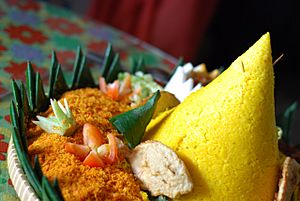Nasi kuning facts for kids

Nasi kuning personal serving, surrounded with rich Indonesian dishes
|
|
| Alternative names | Nasi kunyit, Pulut kuning |
|---|---|
| Course | Main course |
| Place of origin | Indonesia |
| Region or state | Java, nationwide in Indonesia, also found in Malaysia, Singapore, Sri Lanka (known as kaha buth) and South Africa |
| Serving temperature | Hot and room temperature |
| Main ingredients | Rice cooked in turmeric surrounded with side dishes |
| Similar dishes | Hsi htamin |

Nasi kuning is an Indonesian dish that means "yellow rice." It's also sometimes called nasi kunyit, which means "turmeric rice." This fragrant rice dish gets its lovely yellow color and unique taste from being cooked with coconut milk and turmeric.
You can find similar yellow rice dishes in other countries too. In the Philippines, especially among the Maranao people, there's a dish called kuning. It uses turmeric and lemongrass, but not coconut milk. In Sri Lankan cuisine, there's a dish known as kaha buth, which also has influences from Indonesian cooking.
Why Nasi Kuning is Special
In Indonesian culture, nasi kuning is more than just food; it has special meanings. The bright yellow color of the rice reminds people of a pile of gold. Because of this, it's often served at happy and important events. These include parties, housewarmings, welcoming special guests, and opening ceremonies. It's a symbol of good luck, wealth, and respect.
Nasi kuning is very popular all over Indonesia, from Java to Sumatra, Bali, and Sulawesi. It's especially important in Javanese and Minahasa traditions. In Java, nasi kuning is often shaped into a tall cone called a tumpeng. This cone shape is usually eaten during very special celebrations. The very top part of the tumpeng is traditionally given to the oldest or most respected person at the event. One famous type of nasi kuning comes from Manado in North Sulawesi, which is often served with cakalang (a type of fish called skipjack tuna).
Ingredients and How It's Served
The main ingredients that make nasi kuning so special are turmeric and coconut milk. Sometimes, cooks also add pandan leaves and lemongrass while the rice is cooking. These ingredients give the yellow rice its appealing color, wonderful smell, soft texture, and delicious flavor. Other spices like cinnamon, cardamom, cloves, and bay leaves can also be added to make the rice even more aromatic.
Nasi kuning is usually served with many different side dishes. Some common ones include shredded omelette, serundeng (a relish made from grated coconut and spices), urap (vegetables mixed with shredded coconut dressing), and teri kacang (fried anchovies and peanuts). You might also find sambal goreng (fried tempeh and potato in a spicy sauce), ayam goreng (Javanese-style fried chicken), balado udang (shrimp in chili sauce), or perkedel (potato fritters). To make the meal even better, nasi kuning is often served with kerupuk udang (shrimp crackers) or emping chips. It's also common to see it decorated with neatly cut cucumber and tomato slices.
See also
 In Spanish: Nasi kuning para niños
In Spanish: Nasi kuning para niños

